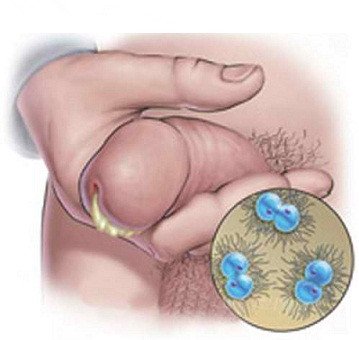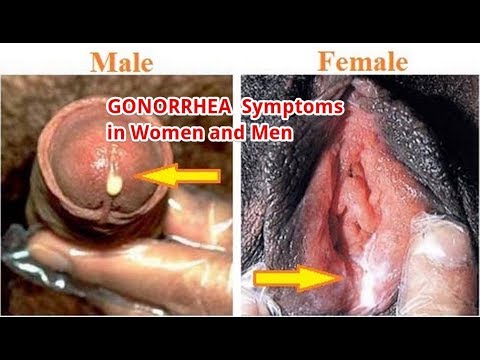Gonorrhea
Gonorrhea can be defined as sexually transmitted disease caused by the bacterium Neisseria gonorrhoeae. A sexually transmitted bacterial infection that, if untreated, may cause infertility.

Many people have no symptoms and some Men may have burning with urination, discharge from the penis, or testicular pain while Women may have burning with urination, vaginal discharge, vaginal bleeding between periods, or pelvic pain.
Complications in women include pelvic inflammatory disease and in men include inflammation of the epididymis. If untreated, gonorrhea can spread to joints or heart valves
Gonorrhea is spread through sexual contact with an infected person. This includes oral, anal, and vaginal sex. It can also spread from a mother to a child during birth. Diagnosis is by testing the urine, urethra in males, or cervix in females.
Testing all women who are sexually active and less than 25 years of age each year as well as those with new sexual partners is recommended; the same recommendation applies in men who have sex with men (MSM).
Causes of gonorrhea
Gonorrhea is caused by the bacterium Neisseria gonorrhoeae. Previous infection does not confer immunity - a person who has been infected can become infected again by exposure to someone who is infected. Infected persons may be able to infect others repeatedly without having any signs or symptoms of their own.
Gonorrhea can be prevented with the use of condoms, having sex with only one person who is uninfected, and by not having sex.
Treatment is usually with ceftriaxone by injection and azithromycin by mouth. Resistancehas developed to many previously used antibiotics and higher doses of ceftriaxone are occasionally required. Retesting is recommended three months after treatment. Sexual partners from the last 2 months should also be treated.
Gonorrhea affects people of about 0.8% of women and 0.6% of men. An estimated 33 to 106 million new cases occur each year, out of the 498 million new cases of curable STI – which also includes syphilis, chlamydia, and trichomoniasis. Infections in women most commonly occur when they are young adults. In 2015, it caused about 700 deaths.
Signs and symptoms
Most women with gonorrhea do not have symptoms, whereas others have vaginal discharge, lower abdominal pain, or pain with sexual intercourse associated with inflammation of the uterine cervix. Most infected men with symptoms have inflammation of the penile urethra associated with a burning sensation during urination and discharge from the penis.
In men, discharge with or without burning occurs in half of all cases and is the most common symptom of the infection.[Men and women can acquire gonorrhea of the throat from performing oral sex on an infected partner, usually a male partner. Such infection does not produce symptoms in 90% of cases, and produces a sore throat in the remaining 10%. In advanced cases, gonorrhea may cause a general feeling of tiredness similar to other infections. It is also possible for an individual to have an allergic reaction to the bacteria, in which case any appearing symptoms will be greatly intensified.
Their incubation period is 2 to 14 days, with most symptoms appearing between 4 and 6 days after infection? Rarely, gonorrhea may cause skin lesions and joint infection (pain and swelling in the joints) after traveling through the blood stream. Very rarely it may settle in the heart causing endocarditis or in the spinal column causing meningitis, both are more likely among individuals with suppressed immune systems, however, having a case of gonorrhea is associated with an increased risk of developing prostate cancer.

Treatment
Sexual partners
It is mostly recommended that sexual partners be tested and potentially treated. One option for treating sexual partners of people infected is patient-delivered partner therapy (PDPT), which involves providing prescriptions or medications to the person to take to his/her partner without the health care provider's first examining him/her
The United States' Centers for Disease Control and Prevention (CDC) currently recommend that individuals who have been diagnosed and treated for gonorrhea avoid sexual contact with others until at least one week past the final day of treatment in order to prevent the spread of the bacterium.
Antibiotic resistance
Many antibiotics that were once effective including penicillin, tetracycline, and fluoroquinolones are no longer recommended because of high rates of resistance.Resistance to cefixime has reached a level such that it is no longer recommended as a first-line agent in the United States, and if it is used a person should be tested again after a week to determine whether the infection still persists.Cases of resistance to ceftriaxone have been reported but are still rare,though public health officials are concerned that an emerging pattern of resistance may predict a global epidemic. The UK's Health Protection Agency reported that 2011 saw a slight drop in gonorrhea antibiotic resistance, the first in 5 years
Antibiotics
Injectable ceftriaxone is one of the few effective antibiotics this is typically given in combination with either azithromycin or doxycycline. As of 2015 and 2016 the CDC and WHO only recommends both ceftriaxone and azithromycin. Because of increasing rates of antibiotic resistance local susceptibility patterns must be taken into account when deciding on treatment.
Progno
If gonorrhea left untreated may last for weeks or months with higher risks of complications. One of the complications of gonorrhea is systemic dissemination resulting in skin pustules or petechia, septic arthritis, meningitis, or endocarditis.This occurs in between 0.6 and 3% of infected women and 0.4 and 0.7% of infected men.
In men, inflammation of the epididymis, prostate gland, and urethra can result from untreated gonorrhea. In women, the most common result of untreated gonorrhea is pelvic inflammatory disease. Other complications include inflammation of the tissue surrounding the liver, a rare complication associated with Fitz-Hugh–Curtis syndrome; septic arthritis in the fingers, wrists, toes, and ankles; septic abortion; chorioamnionitis during pregnancy; neonatal or adult blindness from conjunctivitis; and infertility. Men who have had a gonorrhea infection have an increased risk of getting prostate cancer.
Newborn babies coming through the birth canal are given erythromycin ointment in the eyes to prevent blindness from infection. The underlying gonorrhea should be treated; if this is done then usually a good prognosis will follow. Adults may also have eyes infected with gonorrhoea and require proper personal hygiene and medication.
Among persons in the United States between 14 and 39 years of age, 46% of people with gonorrheal infection also have chlamydial infection.
The World Health Organization estimates that 88 million cases of gonorrhea occur each year, out of the 448 million new cases of all curable STI each year – that also includes syphilis, chlamydia and trichomoniasis In 2013, it caused about 3,200 deaths, up from 2,300 in 1990
Prevention of gonorrhea .
As with most sexually transmitted diseases, the risk of infection can be reduced significantly by the correct use of condoms and can be removed almost entirely by limiting sexual activities to a mutually monogamous relationship with an uninfected person.
Those previously infected are encouraged to return for follow up care to make sure that the infection has been eliminated. In addition to the use of phone contact, the use of email and text messaging have been found to improve the re-testing for infection
Prevention is better than cure.
Can gonorrhea go on its own?
Can chlamydia and gonorrhea just go away without treatment? It is possible that chlamydia and gonorrhea can clear without treatment; however it is more likely that these infections will stay in the body until treated with the right antibiotic. ... Chlamydia can be easily treated and cured with antibiotics.
Thanks for reading this.

Hi! I am a robot. I just upvoted you! I found similar content that readers might be interested in:
https://www.cdc.gov/std/gonorrhea/stdfact-gonorrhea-detailed.htm
Downvoting a post can decrease pending rewards and make it less visible. Common reasons:
Submit